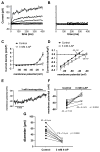KV channels and the regulation of vascular smooth muscle tone
- PMID: 28985443
- PMCID: PMC5760307
- DOI: 10.1111/micc.12421
KV channels and the regulation of vascular smooth muscle tone
Abstract
VSMCs in resistance arteries and arterioles express a diverse array of KV channels with members of the KV 1, KV 2 and KV 7 families being particularly important. Members of the KV channel family: (i) are highly expressed in VSMCs; (ii) are active at the resting membrane potential of VSMCs in vivo (-45 to -30 mV); (iii) contribute to the negative feedback regulation of VSMC membrane potential and myogenic tone; (iv) are activated by cAMP-related vasodilators, hydrogen sulfide and hydrogen peroxide; (v) are inhibited by increases in intracellular Ca2+ and vasoconstrictors that signal through Gq -coupled receptors; (vi) are involved in the proliferative phenotype of VSMCs; and (vii) are modulated by diseases such as hypertension, obesity, the metabolic syndrome and diabetes. Thus, KV channels participate in every aspect of the regulation of VSMC function in both health and disease.
Keywords: KV channels; arterioles; blood flow; microcirculation; potassium channels; resistance arteries; vascular smooth muscle; vasoconstriction; vasodilation.
© 2017 John Wiley & Sons Ltd.
Figures



Similar articles
-
Smooth Muscle Ion Channels and Regulation of Vascular Tone in Resistance Arteries and Arterioles.Compr Physiol. 2017 Mar 16;7(2):485-581. doi: 10.1002/cphy.c160011. Compr Physiol. 2017. PMID: 28333380 Free PMC article. Review.
-
Ion channels and the regulation of myogenic tone in peripheral arterioles.Curr Top Membr. 2020;85:19-58. doi: 10.1016/bs.ctm.2020.01.002. Epub 2020 Feb 25. Curr Top Membr. 2020. PMID: 32402640 Free PMC article. Review.
-
Shaker-related voltage-gated K+ channel expression and vasomotor function in human coronary resistance arteries.Microcirculation. 2018 Jan;25(1):10.1111/micc.12431. doi: 10.1111/micc.12431. Microcirculation. 2018. PMID: 29161755 Free PMC article.
-
Preferential expression and function of voltage-gated, O2-sensitive K+ channels in resistance pulmonary arteries explains regional heterogeneity in hypoxic pulmonary vasoconstriction: ionic diversity in smooth muscle cells.Circ Res. 2004 Aug 6;95(3):308-18. doi: 10.1161/01.RES.0000137173.42723.fb. Epub 2004 Jun 24. Circ Res. 2004. PMID: 15217912
-
Regulation of voltage-gated potassium channels in vascular smooth muscle during hypertension and metabolic disorders.Microcirculation. 2018 Jan;25(1):10.1111/micc.12423. doi: 10.1111/micc.12423. Microcirculation. 2018. PMID: 29044853 Free PMC article. Review.
Cited by
-
Inhibition of voltage-dependent K+ channels by antimuscarinic drug fesoterodine in coronary arterial smooth muscle cells.Korean J Physiol Pharmacol. 2022 Sep 1;26(5):397-404. doi: 10.4196/kjpp.2022.26.5.397. Korean J Physiol Pharmacol. 2022. PMID: 36039740 Free PMC article.
-
Role of Ion Channel Remodeling in Endothelial Dysfunction Induced by Pulmonary Arterial Hypertension.Biomolecules. 2022 Mar 22;12(4):484. doi: 10.3390/biom12040484. Biomolecules. 2022. PMID: 35454073 Free PMC article. Review.
-
Potential mechanism of transient receptor potential cation channel subfamily V member 1 combined with an ATP‑sensitive potassium channel in severe preeclampsia.Exp Ther Med. 2023 May 15;26(1):318. doi: 10.3892/etm.2023.12017. eCollection 2023 Jul. Exp Ther Med. 2023. PMID: 37273761 Free PMC article.
-
Investigating the Cardiovascular Benefits of Dapagliflozin: Vasodilatory Effect on Isolated Rat Coronary Arteries.Int J Mol Sci. 2023 Nov 28;24(23):16873. doi: 10.3390/ijms242316873. Int J Mol Sci. 2023. PMID: 38069193 Free PMC article.
-
Empagliflozin Induces Vascular Relaxation in Rat Coronary Artery Due to Activation of BK Channels.Diabetes Metab Syndr Obes. 2024 Jan 20;17:247-257. doi: 10.2147/DMSO.S419125. eCollection 2024. Diabetes Metab Syndr Obes. 2024. PMID: 38269338 Free PMC article.
References
-
- Aiello EA, Clement-Chomienne O, Sontag DP, Walsh MP, Cole WC. Protein kinase C inhibits delayed rectifier K+ current in rabbit vascular smooth muscle cells. Am J Physiol. 1996;271:H109–119. - PubMed
-
- Aiello EA, Malcolm AT, Walsh MP, Cole WC. Beta-adrenoceptor activation and PKA regulate delayed rectifier K+ channels of vascular smooth muscle cells. American Journal of Physiology. 1998;275:H448–H459. - PubMed
-
- Aiello EA, Walsh MP, Cole WC. Isoproterenol and forskolin increase and PKI inhibits delayed rectifier K+ current in vascular myocytes isolated from rabbit coronary artery and portal vein. CanJPhysiolPharmacol. 1994;72:47.
-
- Aiello EA, Walsh MP, Cole WC. Phosphorylation by protein kinase A enhances delayed rectifier K+ current in rabbit vascular smooth muscle cells. AmJPhysiolHeart CircPhysiol. 1995;268:H926–H934. - PubMed
Publication types
MeSH terms
Substances
Grants and funding
LinkOut - more resources
Full Text Sources
Other Literature Sources
Miscellaneous

